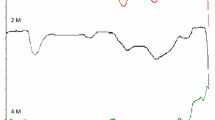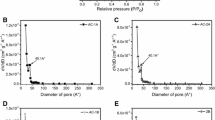Abstract
The novel activated carbon materials were synthesized by the carbonization and chemical activation of agricultural bio-waste from tea woody stems (TWS), and these materials were characterized by using FTIR, SEM, TG/DTA and surface analysis (BET surface area; pore distribution; pore size, area and volume) techniques. The higher carbonization times and amount of chemical reagent generally produce the higher surface area at 400 and 500 °C. The experimental data demonstrated that the highest BET surface area was 789 m2 g−1 at 500 °C, 75 μm particle size, TWS/KOH ratio of 1:2 and carbonization time of 3 h. The activated carbon IR spectrum showed the increases in intense of aromatic C–H out-of-plane bending and C=C vibrations and the disappearance of olefinic C=C functional groups. Thermal analysis curves of TWS are ascribed to decomposition of organic derivate corresponding to lignin, cellulose and hemicelluloses components up to 700 °C from 200 °C. The SEM images and textural analysis data signified that the pore development of carbon skeleton structure during carbonization and activation process formed and type of micropores in these pore structures was dominant.





Similar content being viewed by others
References
Duran C, Ozdes D, Gundogdu A, Imamoglu M, Senturk HB. Tea-industry waste activated carbon, as a novel adsorbent, for separation, preconcentration and speciation of chromium. Anal Chim Acta. 2011;688:75–83.
Gokce Y, Aktas Z. Nitric acid modification of activated carbon produced from waste tea and adsorption of methylene blue and phenol. Appl Surf Sci. 2014;313:352–9.
Gundogdu A, Duran C, Senturk HB, Soylak M, Ozdes D, Serencam H, Imamoglu M. Adsorption of phenol from aqueous solution on a low-cost activated carbon produced from tea industry waste: equilibrium, kinetic, and thermodynamic study. J Chem Eng Data. 2012;57:2733–43.
Gergova K, Petrov N, Eser S. Adsorption properties and microstructure of activated carbons produced from agricultural by-products by steam pyrolysis. Carbon. 1994;32:693–702.
Tonucci MC, Gurgel LVA, de Aquino SF. Activated carbons from agricultural byproducts (pine tree and coconut shell), coal, and carbon nanotubes as adsorbents for removal of sulfamethoxazole from spiked aqueous solutions: kinetic and thermodynamic studies. Ind Crop Prod. 2015;74:111–21.
Zhang K, Agrawal M, Harper J, Chen R, Koros WJ. Removal of the fermentation inhibitor, furfural, using activated carbon in cellulosic-ethanol production. Ind Eng Chem Res. 2011;50:14055–60.
Ramos ME, Bonelli PR, Blacher S, Carrott MMLR, Carrott PJM, Cukierman AL. Effect of the activating agent on physico-chemical and electrical properties of activated carbon cloths developed from a novel cellulosic precursor. Colloid Surf A. 2011;378:87–93.
Ramos ME, Bonelli PR, Cukierman AL, Carrott MMLR, Carrott PJM. Adsorption of volatile organic compounds onto activated carbon cloths derived from a novel regenerated cellulosic precursor. J Hazard Mater. 2010;177:175–82.
Usmani TH. Preparation and characterization of activated carbon fibre/filament (ACF) from indigenous cellulosic precursors. J Chem Soc Pak. 2002;24:98–101.
Plaza-Recobert M, Trautwein G, Perez-Cadenas M, Alcañiz-Monge J. Preparation of binderless activated carbon monoliths from cocoa bean husk. Microporous Mesoporous Mater. 2017;243:28–38.
Li S, Han K, Li J, Li M, Lu C. Preparation and characterization of super activated carbon produced from gulfweed by KOH activation. Microporous Mesoporous Mater. 2017;243:291–300.
Baysal M, Bilge K, Yılmaz B, Papila M, Yürüm Y. Preparation of high surface area activated carbon from waste-biomass of sunflower piths: kinetics and equilibrium studies on the dye removal. J Environ Chem Eng. 2018;6:1702–13.
Gupta H, Singh S. Kinetics and thermodynamics of phenanthrene adsorption from water on orange rind activated carbon. Environ Technol Innov. 2018;10:208–14.
Nunes EN, Rocha AT, de Araújo GT, Padre de Paz A, de Sousa Rodrigues LM, Batista RS, Melo TB. Characterization of yellow mombin biomass (Spondias mombin L) for production of activated carbon. J Therm Anal Calorim. 2018. https://doi.org/10.1007/s10973-018-7545-8.
Inal IIG, Holmes SM, Banford A, Aktas Z. The performance of supercapacitor electrodes developed from chemically activated carbon produced from waste tea. Appl Surf Sci. 2015;357:696–703.
Aworn A, Thiravetyan P, Nakbanpote W. Preparation and characteristics of agricultural waste activated carbon by physical activation having micro- and mesopores. J Anal Appl Pyrolysis. 2008;82:279–85.
Soleimani M, Kaghazchi T. Agricultural waste conversion to activated carbon by chemical activation with phosphoric acid. Chem Eng Technol. 2007;30:649–54.
Kadirvelu K, Kavipriya M, Karthika C, Radhika M, Vennilamani N, Pattabhi S. Utilization of various agricultural wastes for activated carbon preparation and application for the removal of dyes and metal ions from aqueous solutions. Bioresour Technol. 2003;87:129–32.
Correia LB, Fiuza RA, de Andrade RC, Andrade HMC. CO2 capture on activated carbons derived from mango fruit (Mangifera indica L.) seed shells. J Therm Anal Calorim. 2018;131:579–86. https://doi.org/10.1007/s10973-017-6542-7.
Azad FN, Ghaedi M, Dashtian K, Hajati S, Pezeshkpour V. Ultrasonically assisted hydrothermal synthesis of activated carbon-HKUST-1-MOF hybrid for efficient simultaneous ultrasound-assisted removal of ternary organic dyes and antibacterial investigation: Taguchi optimization. Ultrason Sonochem. 2016;31:383–93.
Zhu X, Yu S, Xu K, Zhang Y, Zhang L, Lou G, Wu Y, Zhu E, Chen H, Shen Z, Bao B, Fu S. Sustainable activated carbons from dead ginkgo leaves for supercapacitor electrode active materials. Chem Eng Sci. 2018;181:36–45.
Danisha M, Ahmadb T. A review on utilization of wood biomass as a sustainable precursor for activated carbon production and application. Renew Sustain Energy Rev. 2018;87:1–21.
Enniyaa I, Rghiouib L, Jourania A. Adsorption of hexavalent chromium in aqueous solution on activated carbon prepared from apple peels. Sustain Chem Pharm. 2018;7:9–16.
Gonzalez-Garciaa P, Centenob TA, Urones-Garrotec E, Avila-Brandea D, Otero-Diaza LC. Microstructure and surface properties of lignocellulosic-based activated carbons. Appl Surf Sci. 2013;265:731–7.
Suhas, Carrott PJM, Carrott MMLR. Lignin—from natural adsorbent to activated carbon: a review. Bioresource Technol. 2007;98:2301–12.
Liou TH. Development of mesoporous structure and high adsorption capacity of biomass-based activated carbon by phosphoric acid and zinc chloride activation. Chem Eng J. 2010;158:19–142.
Ahmadpour A, Do DD. The preparation of active carbons from coal by chemical and physical activation. Carbon. 1996;34:471–9.
El-Sheikh AH, Newman AP, Al-Daffaee HK, Phull S, Cresswell N. Characterization of activated carbon prepared from a single cultivar of Jordanian Olive stones by chemical and physicochemical techniques. J Anal Appl Pyrolysis. 2004;71:151–64.
Skubiszewska-Zięba J, Charmas B, Kołtowski M, Oleszczuk P. Active carbons from waste biochars. J Therm Anal Calorim. 2017;130:15–24. https://doi.org/10.1007/s10973-017-6143-5.
Bedin KC, Martins AC, Cazetta AL, Pezoti O, Almeida VC. KOH-activated carbon prepared from sucrose spherical carbon: adsorption equilibrium, kinetic and thermodynamic studies for methylene blue removal. Chem Eng J. 2016;286:476–84.
Hameed BH, Daud FBM. Adsorption studies of basic dye on activated carbon derived from agricultural waste: Hevea brasiliensis seed coat. Chem Eng J. 2008;139:48–55.
D’Souza F, Kadish KM. Handbook of carbon nano materials., World Scientific series on carbon nanoscienceHackensack: World Scientific; 2011.
Gergova K, Eser S. Effects of activation method on the pore structure of activated carbons from apricot stones. Carbon. 1996;34:879–88.
Lozano-Castello D, Lillo-Rodenas MA, Cazorla-Amoros D, Linares-Solano A. Preparation of activated carbons from Spanish anthracite I. Activation by KOH. Carbon. 2001;39:741–9.
Guo Y, Yang S, Yu K, Zhao J, Wang Z, Xu H. The preparation and mechanism studies of rice husk based porous carbon. Mater Chem Phys. 2002;74:320–3.
Pastor-Villegas J, Gomez-Serrano V, Duran-Valle CJ, Higes-Rolando FJ. Chemical study of extracted rockrose and of chars and activated carbons prepared at different temperatures. J Anal Appl Pyrolysis. 1999;50:1–16.
Lua AC, Yang T. Effect of activation temperature on the textural and chemical properties of potassium hydroxide activated carbon prepared from pistachio-nut Shell. J Colloid Interface Sci. 2004;274:594–601.
Zanoaga M, Tanasa F, Mamunya Y. Compatibilized green composites based on wood chips and thermoplastic polymer waste matrices. Cell Chem Technol. 2016;50:637–48.
Plis A, Kotyczka-Moranska M, Kopczynski M, Labojko G. Furniture wood waste as a potential renewable energy source: a thermogravimetric and kinetic analysis. J Therm Anal Calorim. 2016;125:1357–71.
Marsh H, Rodríguez-Reinoso F. Activated carbon. 1st ed. Amsterdam: Elsevier; 2006.
Thommes M, Kaneko K, Neimark AV, Olivier JP, Rodriguez-Reinoso F, Rouquerol J, Sing KSW. Physisorption of gases, with special reference to the evaluation of surface area and pore size distribution (IUPAC technical report). Pure Appl Chem. 2015;87(9–10):1051–69.
Acknowledgements
The authors are grateful to the Recep Tayyip Erdoğan University for the financial and technical supports of this work and Sinop University.
Author information
Authors and Affiliations
Corresponding author
Ethics declarations
Conflict of interest
The authors declare that there is no conflict of interest regarding the publication of this paper.
Additional information
Publisher's Note
Springer Nature remains neutral with regard to jurisdictional claims in published maps and institutional affiliations.
Rights and permissions
About this article
Cite this article
Tabak, A., Sevimli, K., Kaya, M. et al. Preparation and characterization of a novel activated carbon component via chemical activation of tea woody stem. J Therm Anal Calorim 138, 3885–3895 (2019). https://doi.org/10.1007/s10973-019-08387-2
Received:
Accepted:
Published:
Issue Date:
DOI: https://doi.org/10.1007/s10973-019-08387-2




